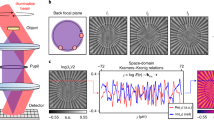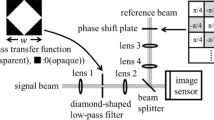Abstract
This paper presents a new “hybrid” method whereby the ratio of the isochromatic-fringe visibility/isopachic-fringe visibility may be easily and continuously varied. This simple procedure merely combines a conventional polariscope with a holographic system. A variable beam splitter permits an incoherent superposition of the reconstruction of a doubly exposed hologram with real-time isochromatics, either dark or light field. By varying the ratios of the above two, in the image plane, numerous interesting results may be obtained including:
-
(1)
Isochromatics only, without errors in position
-
(2)
Isochromatics-isopachic fringes identical to those obtained through classical interferometry
-
(3)
Isochromatic-isopachic fringes whereby the amplitude modulation between the two may be minimized
-
(4)
Continuously variable isopachic/isochromatic-fringe visibility.
Similar content being viewed by others
References
Balaš, J., Szabó, V. and Hovanesian, J. D., “Holograficko-Interferečná Metóda v Experimentalnej Pružnosti,” Stavenicky Casopis, Foğn xx, Cisio 6, Bratislava, Czechoslovakia (1972).
Post, D., “Holography and Interferometry in Photoelasticity,”Experimental Mechanics,12(3)113–123, (1972).
Sciammarella, C. A. andQuintanilla, G., “Techniques for the Determination of Absolute Retardation in Photoelasticity,”Experimental Mechanics,12(2),57–66, (1972).
Sanford, R. J. andDurelli, A. J., “Interpretation of Fringes in Stress-Holo-Interferometry,”Experimental Mechanics,11(4),161–166 (1971).
Holoway, D. C. andJohnson, R. H., “Advancements in Holographic Photoelasticity,”Experimental Mechanics,11(2),57–63 (1971).
Sinclair, D., “A New Optical Method for the Determination of Principal Stress Sum,” Proc. 10th Semi-Annual Photoelasticity Conf. (Dec. 1939).
Hovanesian, J. D., “Isochromatic and Isopachic Intensification in Stress-Holo-Interferometry,” Wayne State Univ. Research Rept. (1967).
Hovanesian, J. D. and Haskell, R. E., “Influence of Polarization Parameters on Isochromatics in Photoholoelasticity,” Proc. Symp. on Experimental Mechanics, Univ. of Waterloo (June 12–16, 1972).
Cascarano, F., “Computer Simulation of Isochromatic-Isopachic Fringes in Photoholoelasticity,” Oakland Univ. Graduate Research Report, School of Engineering (1973).
Fourney, M. E. andMate, K. V., “Further Applications of Holography to Photoelasticity,”Experimental Mechanics,10(5),177–186, (1970).
Author information
Authors and Affiliations
Rights and permissions
About this article
Cite this article
Der Hovanesian, J. Variable isochromatic/isopachic-fringe visibility in photoholoelasticity. Experimental Mechanics 14, 233–236 (1974). https://doi.org/10.1007/BF02323324
Issue Date:
DOI: https://doi.org/10.1007/BF02323324




